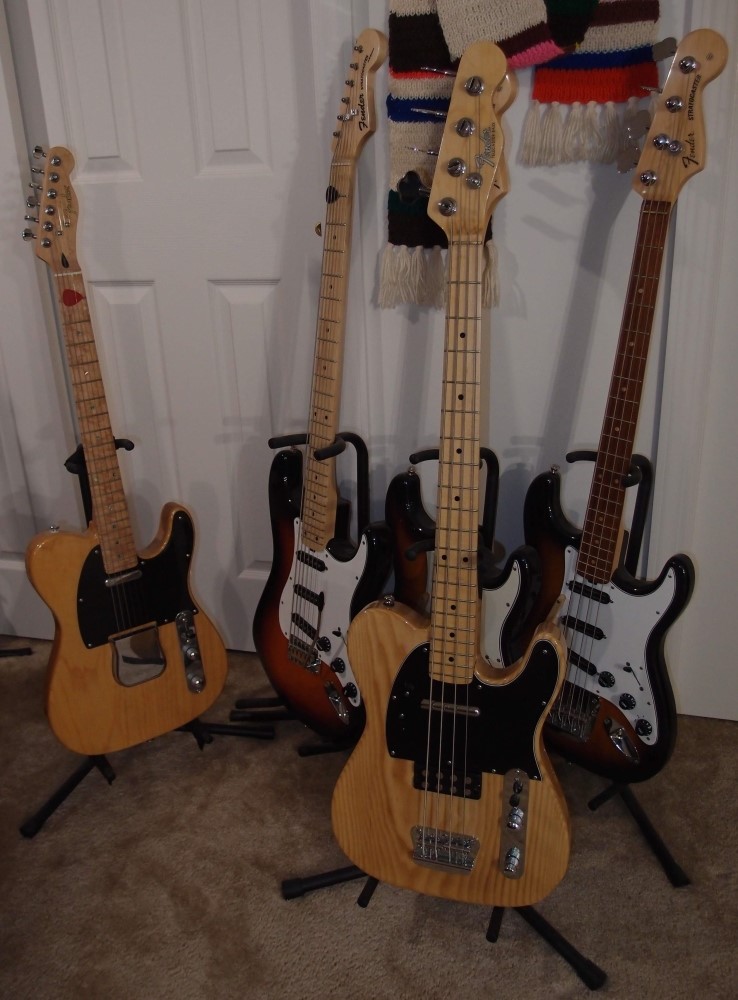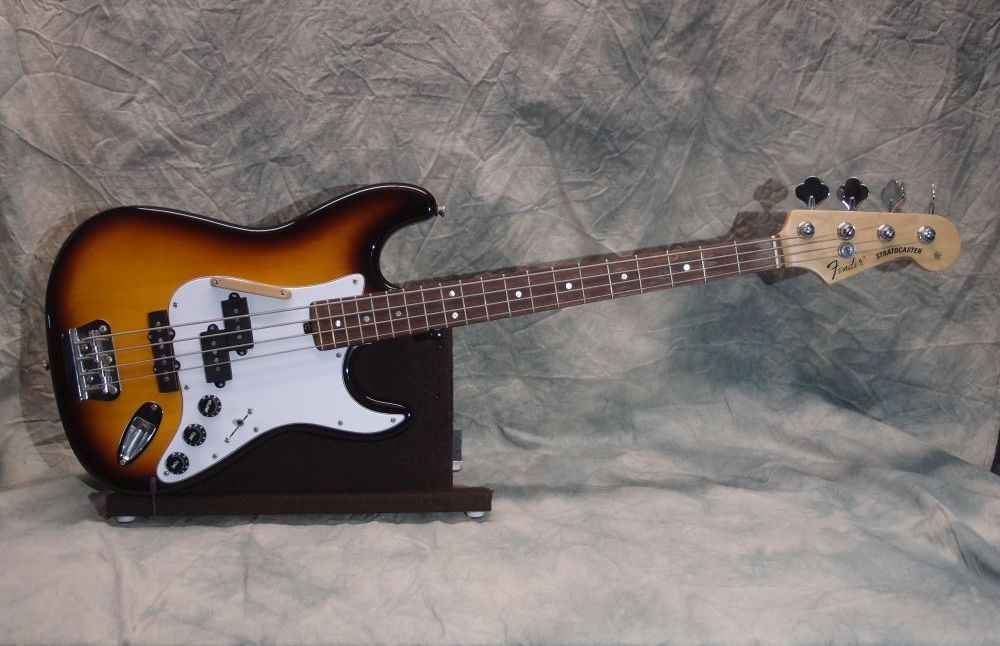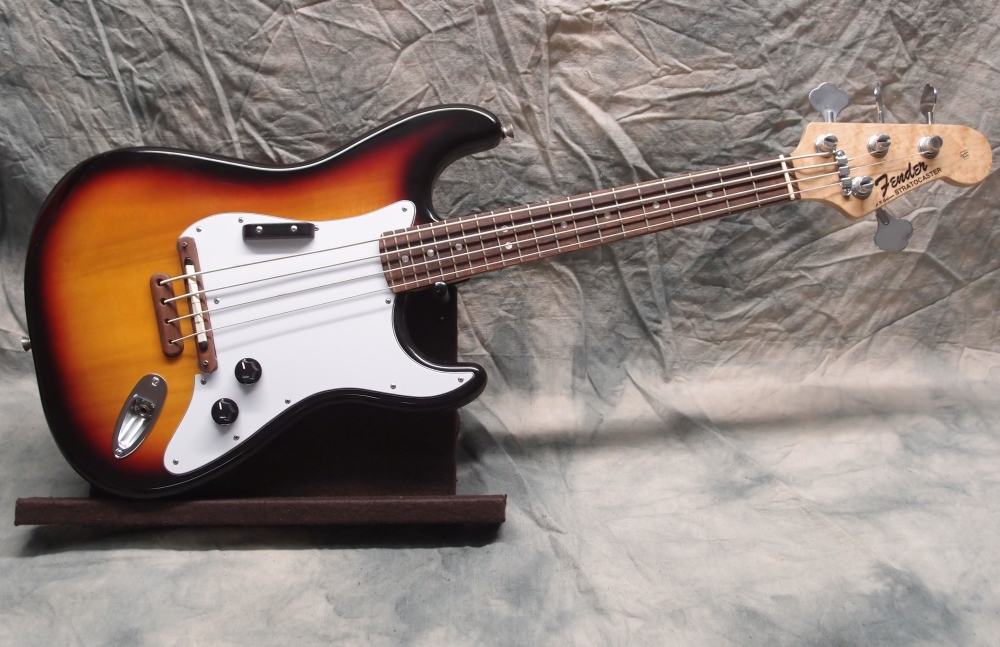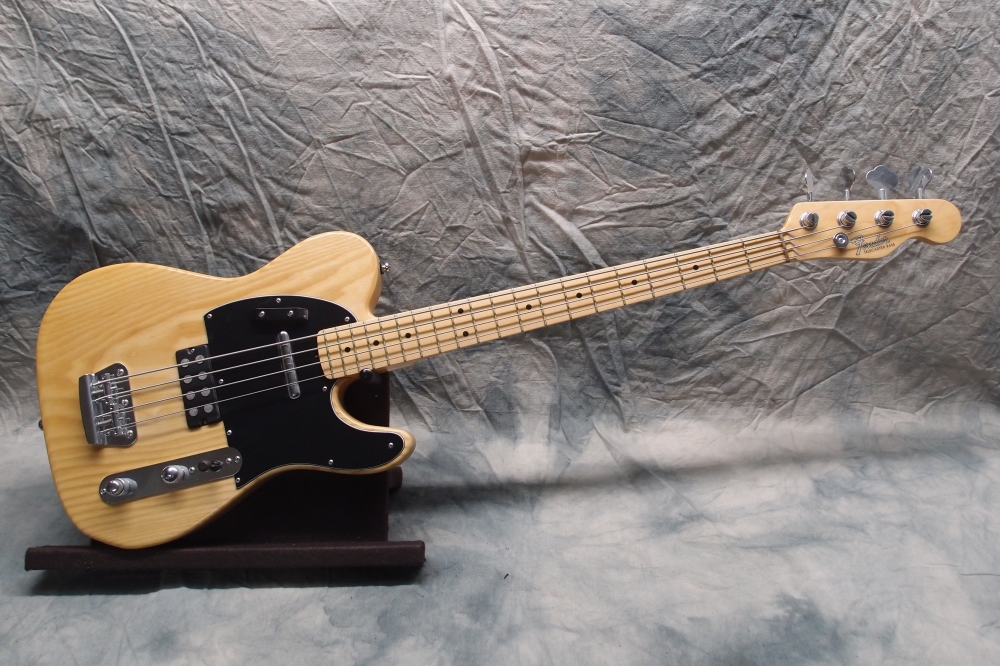Telecaster Bass (2/2)

Ash, sanded, grain-filled, re-sanded, and three coats of Minwax "Natural" stain. Natural gives a slightly yellow hue, not a real Fender "Butterscotch", but a lot nicer than the whitish color you can see inside the cavities. Next up - several coats of brush-on poly, then wets-sanding & final polishing.

... coming along nicely ... on my new painting jig, getting slathered in free triple-thick polyurethane. Once I think the plastic coating is thick enough, I'll set it aside for a few weeks to harden, and then wet sand and polish. The grain-filling, in this case, was academic - this poly goop would have filled the grain just the same I think. If you look close, you can just make out the tummy cut on the back. On a Telecaster? Sacrilege! At least I didn't put an arm cut on it.
The color is really getting nice, and most polys tend to yellow over time, so it should eventually get to be a nice butterscotch. It's a pretty piece of wood too, although the back has some darkening of the heartwood that might be called a flaw. I don't mind it at all, and it's just the back anyway.
The rest of the build is:
- 32" maple neck with 'tele' headstock
- black pg
- lipstick neck pickup for the classic tele look
- hb bridge pickup
- bronco bridge - 2 saddle, in the tele spirit of crudeness
- 4-way pickup switch with series/parallel options
- fully active electronics with bypass ( GuitarFuel.com )
- stacked bass & treble - classic 2-knob setup
My goal is to keep to the telecaster style and design as much as possible. A skinny chrome neck pickup was a must, as was the 2-saddle bridge and minimal controls - just 2 knobs and 1 switch showing. Much the same way that I kept the classic Strat control layout in the other projects.
The Stratocaster family's cousin from the country has come a-visitin':

He may be from the woods, but he's got tech - look close - active bass and treble controls. A pull switch on the volume gives passive/dead battery mode. One thing that didn't make the final cut was the series/parallel switch. With the two pickups - hot lipstick and high-output humbucker - series mode just didn't work, so I took that expensive switch out and put in a cheap three-way. Also has a spoke-nut double-acting truss rod.
The neck waited for a body for so long that it 'dried' dead straight. Right now, the truss rod is pushing it forward. I expect after a few weeks under tension it will sort itself out. That is why a double-acting truss rod is critical in a short-scale bass - the string tension may not be enough to counteract the back bow induced by installing the frets. A temporary front-shimming and it plays ok for now.
You'd think the two-saddle bridge would hurt intonation, but it really doesn't, I hardly needed to adjust it at all. With the solid ash body, it is heavy, a little over 10 pounds. That's a lot more than any of the Strats.
Tone-wise, I really can't say it sounds like anything else. With the active controls and two hugely different pickups, the range is probably the widest of anything I've ever heard. The pickups are sort-of in the Ric positions, but the humbucker sounds nothing like a Ric.
It's an odd combination, the humbucker completely swamps the lipstick. When I designed it, I was going more for a visual aesthetic than a particular sound, I really had no idea what it would sound like. It's too soon to say what I think of it.
Anyway, that's the preliminary, maybe in a month it will have settled-in to where I can do a final setup and really get it tweaked.
The neck and body were made for each other. While there are a number of ways to seamlessly convert a stock Strat body to a bass, there is no neat way to convert a Tele. The Tele guitar body has routs and holes in all the wrong places, you'd either have to obviously cover them up, or build it from scratch, which is what I did. The neck is also custom, from the truss rod out - you can't buy a neck like this. Notice it has a rounded Strat heel, not a squared-off Tele heel. Easier to build. The headstock is bass-sized, with a brass nut.
The body outline is exactly as a guitar, but the tongue behind the neck is extended to support the 30" bass neck. The neck pocket is also Strat, while the string spacing is 2-1/16" to fit the narrower neck, necessitating the Bronco bridge, which is in keeping with the Tele design anyway, as the classic Telecaster uses shared saddles. The body also has a Strat-style cutaway on the back, but not on the front, so that it still looks like a Tele slab.
After actually playing it a while ( what a concept ! ) I've decided that the humbucker is way too boomy and needs a governor to play nice with the lipstick, which has a much more pleasing tone, very Ric-like. The lipstick works even better with the bass-boost.
Since I did away with the series option, added a fixed volume control on the humbucker becomes a possibility - just a tiny trim pot inside the control cavity. I think that humbucker came off one of the Squier Jaguars, which are aimed at people who appreciate loud and awful. I wish I'd used a MusicMan instead, that was my original idea. But I was intending this whole piece to be an experiment, and you don't learn anything doing what you already know works.
The internal volume control on the humbucker allows me to match its output level to the lipstick, otherwise, the humbucker would swamp the single-coil. The pot is wired as a variable resistor, in series with the pickup, no connection to ground, so that it only affects the humbucker. Leave the leads long so that you can hang it out of the body to tweak it. When you are happy with the balance, wrap it in tape, lift up the pickguard and shove it inside.
There are several problems with converting a Tele guitar body to a bass. The guitar body has a number of holes and routs in bad places, and the pickguard only covers half of the body and is fairly useless for hiding anything.
While a 24-fret 30" neck places the bridge in the same spot, you still have the damage from the ashtray Tele bridge to deal with. Also, a neck that long ( as long as a long-scale ) will un-balance the horn-less Tele body.
With a factory Tele body, you just can't cover up the guitar origins. That is why I decided to build my Tele from scratch. It's a fairly easy body to build, with just one horn, simple edges, and no 3-d contouring, although I added a belly cut to mine. A Stratocaster body is much easier to convert, there are any number of options.
One option to convert a Tele body to a bass would be to build a 24-fret 30" scale neck. This would leave the bridge in the same place. A long Musicman-style bass bridge will cover much of the guitar damage. A Musicman pickup right up against the bridge plate should cover the rest. With some careful routing, you can even re-use the guitar pickguard. The neck pickup can stay. The neck pocket will also have to be widened-out a bit for a standard-width bass neck. Note that such a neck is the same length as a typical long-scale, and balance may not be very good. Lightweight tuners will help with that.
If you don't want to build your own neck, a standard 34" unlined fretless would work. One could even conceivably install frets ( or lines ) on a fretless neck, but I have never tried it.



















Questions or Inquiries?
Just want to say Hello? Sign the .